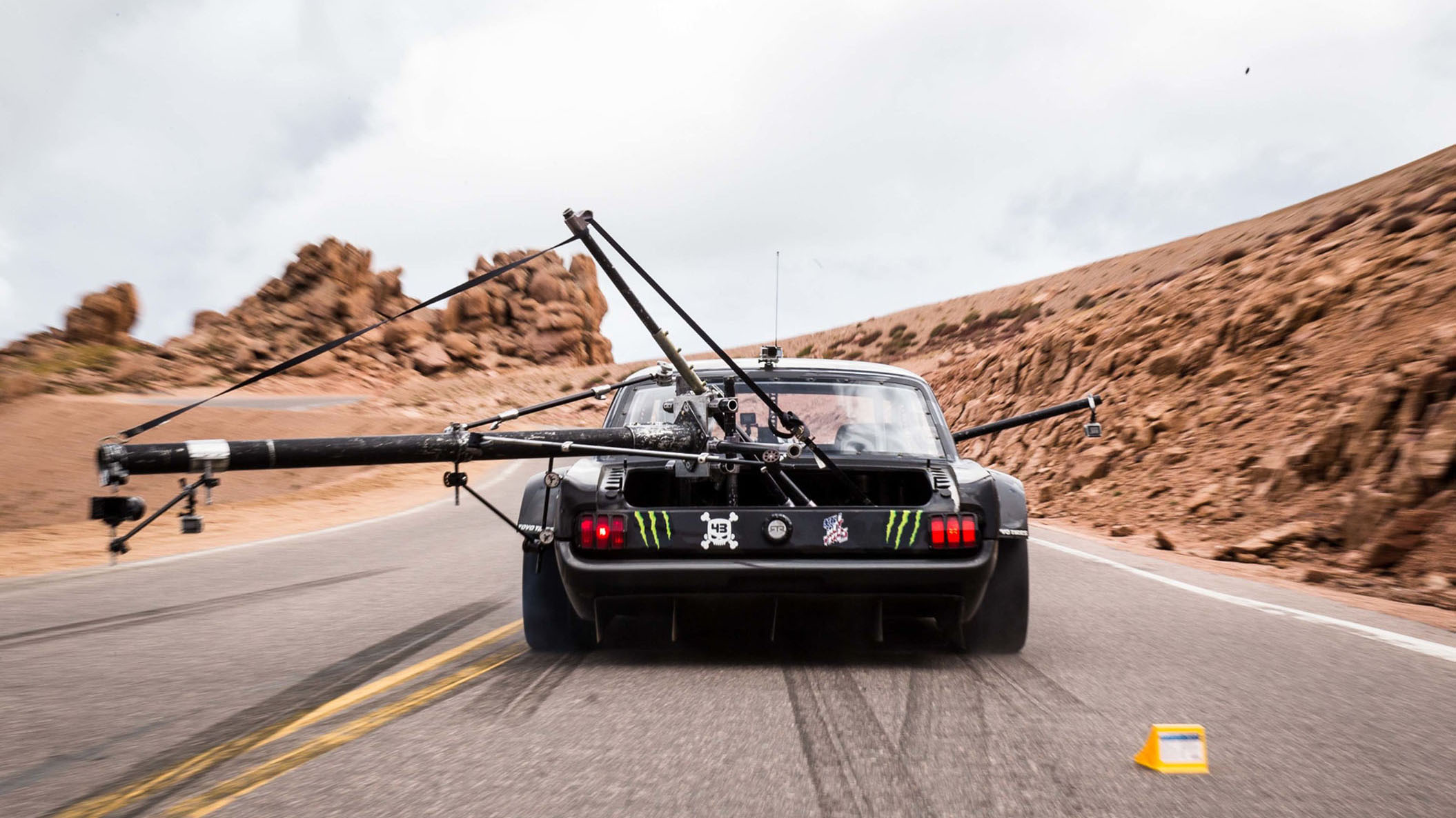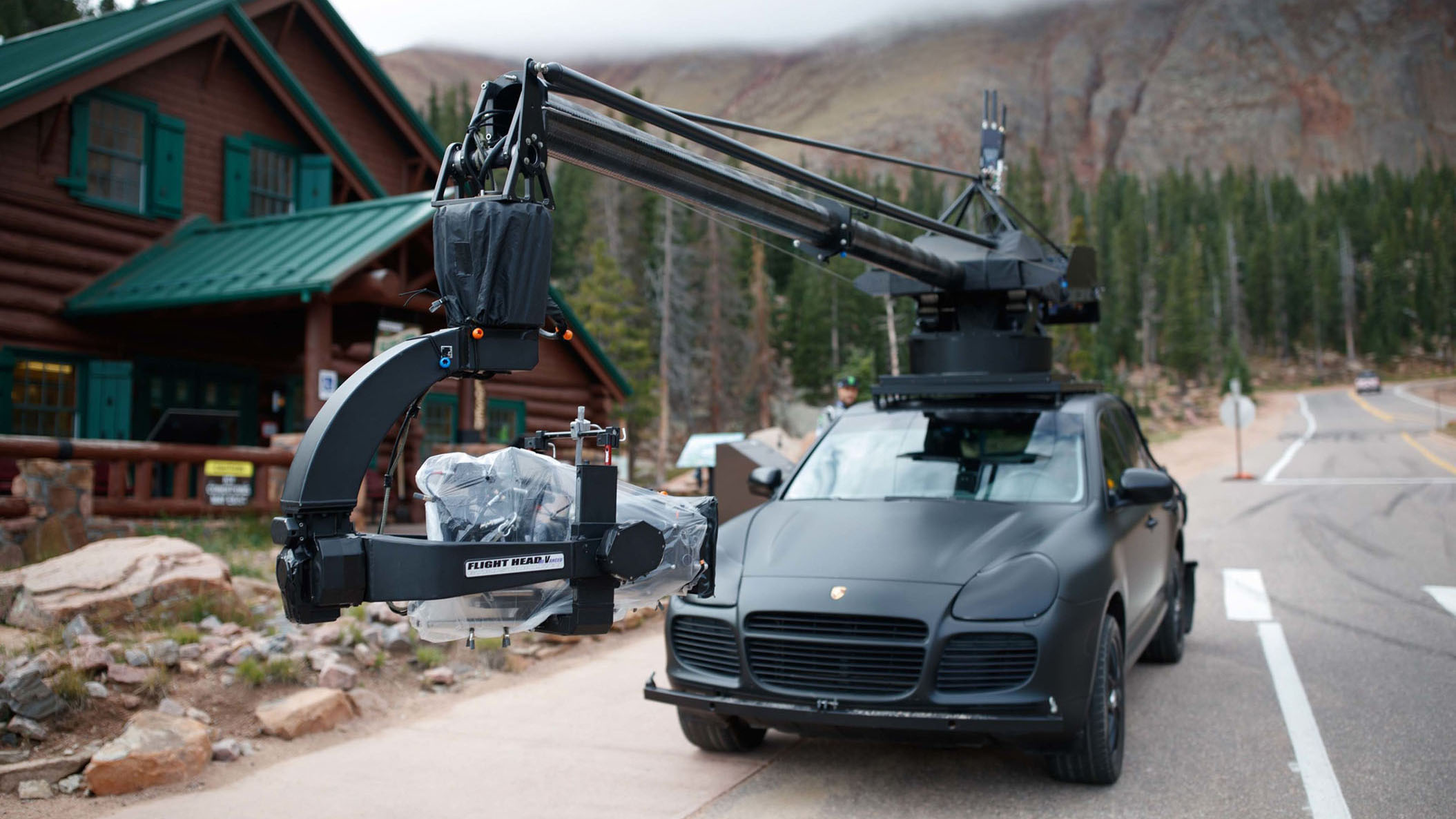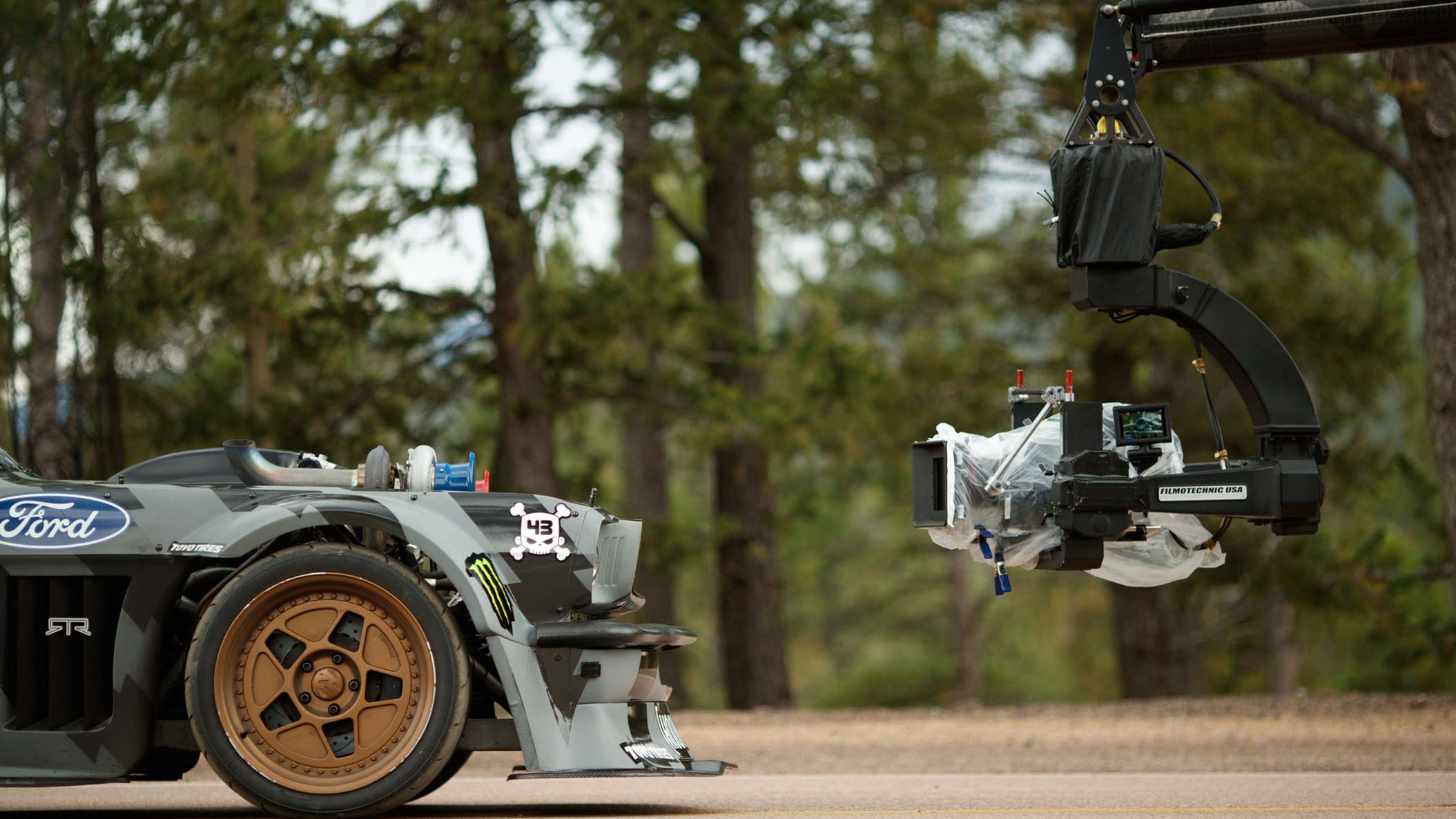By Carter Jung
Climbkhana is clever. And no, not because it’s a portmanteau. Rather it’s how Ken Block and his merry band of Hoonigan Media Machine misfits took something the internet clearly loves, hooning, and paired it with a picturesque mountain tied to one of the oldest motorsport events in America, the Pikes Peak International Hill Climb.
More than that, tire-shredding drifts and thick clouds of smoke from the Hoonicorn V2 — a 1,400-horsepower 1965 Ford Mustang converted to all-wheel drive, harkens back to the glory days of Pikes Peak. A time when car and driver would test their mettle racing up a precarious ribbon of dirt to 14,115 feet of elevation.
The new Climbkhana video is the latest chapter in the Gymkhana series. Watch the video on Monday, Sept. 25, when it debuts on YouTube.
Ahead of the debut, we talked with head Hoonigan Ken Block and Brian Scotto, co-director of Climbkhana and longtime Gymkhana collaborator.
AUTOBLOG: With this video, you’ve strayed from the Gymkhana naming convention, opting for Climbkhana. There’s also the recent Terrakhana video. Is there meaning behind the shift?
BLOCK: Climbkhana and Terrakhana were both names that we all — Brian, myself and our team — came up with for these projects. The goal was to make it clear that while they’re related in the sense that it’s myself driving and incorporating Gymkhana-style moves, they’re new ideas.
AB: Ken, your first exposure to Pikes Peak was watching the hill climb on TV as a youth. When did you decide to film your own four-wheeled exploits on the mountain?
BLOCK: We had been talking about doing Climbkhana at Pikes Peak when someone from the hill climb organization reached out to us. The timing aligned perfectly, and we were all on the same page about doing something cool to showcase the mountain in a way that wasn’t the standard hill climb footage. We wanted to be respectful to the event, pay a bit of respect to Climb Dance, and create something that was still very much in line with what people expect from my videos.
AB: Did you ever compete in the annual Pikes Peak International Hill Climb?
BLOCK: I raced at Pikes back in 2005 in a Group N rally car! Although by the time I got to the top, it was a very underwhelming experience due to the lack of power thanks to the elevation.
AB: Brian, a segue, how did you get involved with the Gymkhana films?
SCOTTO: I’ve been on this ride since day one. The first Gymkhana film actually grew from an article that ran in 0-60 Magazine — which I was the editor of — about the sport of gymkhana, featuring Ken. I consulted on the first and second Gymkhana films, but by the time we released the third, I was full-time working for Ken. I stepped into the role of creative director and then eventually graduated to director, but I sort of still do both jobs.
Now, Ken is my business partner at Hoonigan, and for some reason trusts me to carry on his creation.
AB: It’s incredibly challenging to close down Pikes Peak — the highway is a public toll road. It’s why, for the hill climb, practice is held in segments at dawn over the week leading into race day. How were you able to convince the authorities to give you access to the mountain?
SCOTTO: Luckily, the team at Pikes Peak International Hill Climb had come to us, and were instrumental in navigating this project through the parks department. But we still had to work around the mountain’s schedule. We shot super early during the mornings and did controlled traffic stops to get other shots pulled off after 7:30 a.m. when the mountain opened to the public. It was no easy task. But everyone from the mountain was amazing to work with, they really seemed to appreciate what the world of motorsports did for Pikes Peak.
AB: Past Gymkhana films were in production for a scant five days. Climbkhana took more than 13 months. What were some of the challenges you faced?
BLOCK: It definitely took us longer than I would have liked to finish! The first time we went, we had some fairly serious engine problems and were unable to get everything we wanted. We went back two months later and were still having engine issues and ran into severe weather issues. Rain, snow, lightning and sunshine all within an hour at times. Some truly wild stuff! Finally, we sorted out the motor and went back this past August and had two solid days of good weather to finish everything up.
AB: How much did having Jeff Zwart co-direct help with production?
SCOTTO: Jeff Zwart is a legend. As a kid, photos he shot decorated the walls of my room, so I was honored to not only work alongside him and share directing duties, but to have him so excited to be a part of the project and join the Hoonigan Media Machine crew. Without Zwart’s extensive knowledge of the road, it would have taken us three times as long to plot it all out.
Not only has he raced there a zillion times, he has also shot a bunch of car commercials there, so he knew it from both sides. Zwart also brought a different look to the film — we have never used camera cars before. Not using them has always been a big part of our formula, but Zwart and I were able to find a way to make them work while staying true to our signature style.
AB: When it comes to driving, is it pre-planned and storyboarded from previous scouting trips or more seat-of-the-pants?
BLOCK: There’s always a scouting trip prior, and then we’ll do a recon pass before we start to film. For normal Gymkhana stuff, I can normally walk through the scene, but with Climbkhana, since it was the road and extended distances, I used my Focus RS to run through the sections before hopping into the Hoonicorn to film.

AB: You mentioned the film before, how many times did you and the crew watch Jean Louis Mourey’s Climb Dance before going into production?
BLOCK: Maybe twice? But, I have seen it many times and I know a lot of the scenes by heart. It’s very inspirational. And, it has a lot of the basic makings of how we make our videos since most of the footage was shot during the various practices of the two drivers before the race, Ari Vatanen and Robby Unser.
SCOTTO: I’m sure I’ve seen that film a hundred times in my life. Before we started doing the Gymkhana series, it was really the only film of its kind that was more than the typical motorsports coverage. Mourey elevated the way racing could be depicted. There’s a lot of commonality in Climb Dance and our work. Many people think that it was shot during the race, but the film was actually shot just like Climbkhana, in the wee hours of the day, during practice and private testing. Oh, and I probably watched the iconic Ari Vatanen sun block shot 30 times on the day we filmed that homage moment to get everything just right.
AB: With the hill climb having recently celebrated its 101st anniversary and Pikes Peak being one of the most scenic motorsports settings in the world, there has been a lot of content to come out of the mountain. What was your take going into it?
BLOCK: I saw the road and mountain for what it was: one of the most amazing races in the world on one of the most amazing mountain roads. So, our vision was to help showcase what an amazing and challenging road it is, but to show it in a new way.
Since the road has been completely paved, everyone who races up Pikes Peak is now locked into tarmac racing lines. No one gets sideways anymore like the old gravel days, which is when I started watching the race. With Climbkhana, I wanted to show a more fun, sideways and playful way of getting to the summit.
AB: In previous Gymkhana films, you had a sandbox to play in, from an old airfield to what seemed like the entirety of Los Angeles. With Climbkhana, you were limited to the paved sections of the mountain. How did that affect the film?
BLOCK: It made it a bit more dangerous at certain points since my runoff was a sheer drop at times! It also restricted what we could do since there are only so many open areas, or unique spots like the ranger station and the parking lot next to it to play with. We can only show so many hairpins in a video like this, so we had to get creative with the various spots and storylines we could create on the mountain.
AB: What was the most challenging stunt in Climbkhana?
BLOCK: There’s one turn in the upper part of the W’s where I wanted to drop a wheel and spray some rocks out over the drop while still smoking the front tires on the pavement. Not easy! And the consequences were bad if I went wide, it’s the same spot the Mitsubishi Lancer Evolution went off a few years ago. I nailed it on my second run, but the commitment level was really high and the margin for error was pretty small, so I’d say that was by far the most challenging part.


AB: What shot are you the most proud of?
SCOTTO: That’s a tough one. The shot of KB almost dying, with two wheels deep in the dirt, inches from disaster as his front wheels clawed at the tarmac to escape the long way down might be one of the greatest moments I have ever been apart of. I was standing behind our main camera for that shot, and didn’t breathe the entire time.
AB: While the plumey tire smoke almost doubles as roost, what would you each trade to go back and shoot Climbkhana when Pikes Peak was still all gravel?
BLOCK: Most of my early race career was built on gravel rally experience, and my early memories of Pikes was of it all gravel. So, it would be a dream to actually drive it that way. Especially with a high-horsepower AWD rally car. So, as far as a trade? That’s a tough question. Not my left nut, that’s for sure. But it does have that sort of value, though [laughter]!
SCOTTO: Early on, something we discussed was that by making a Gymkhana film, it was the only way anyone would be able to drive the mountain in the same fashion as the glory days of Michelle Mouton, Ari Vatanen, Bobby Unser, Walter Rohl, Rod Millen and so on. So I’m not so sure I’d trade anything. That said, the rally fan in me wishes the mountain was still gravel for racing’s sake. The faster records are cool, but nothing will beat the sideways, roosted slides with no guardrails and heaps of consequence.
AB: Ken, as someone who currently competes in the FIA World Rallycross Championship, how much does your skills hooning in videos complement what you do in a race?
BLOCK: All of the stuff you see in my videos is a direct translation from the things I would do on a rally stage or during a rallycross race. But, sideways is slow so are we are constantly fighting to keep the car straight when racing in the World Rallycross Championship. The Gymkhana videos are always fun for me to get that sideways stuff out of my system.
When Gymkhana first dropped back in 2008, it was during the early YouTube days. Do you remember what your initial expectations were?
BLOCK: I had none, really. I originally filmed it for fun and had it hosted on my personal webpage. It took off and was costing me around $10k a month to host it there! Once that happened, I knew I had something pretty special, and it’s grown a lot from there.

AB: Besides excessive hosting fees, how much has the success of the Gymkhana franchise affected both of your careers?
BLOCK: I think the success of the franchise has certainly helped in terms of extra visibility as a driver and for my team and partners. It allows me to be a bit more multi-faceted than most guys on the circuit and it assisted in getting more sponsorship, which is a huge help when building out race budgets to compete around the world.
SCOTTO: Gymkhana changed the direction of my career. I went from being a magazine editor to a director. Not sure if that would have happened without this series. But then again, the entire world of media was shifting at the time, and we were all trying to figure out what the next thing was. Who knew it was making videos about sliding cars!
AB: As creators, where do you both find inspiration for your projects?
BLOCK: I find my inspiration all around me. At the end of the day, my team and I love to create cool content that we like and want to see. Through the process of brainstorming and general banter, we get inspired to come up with our ideas for the next video.
SCOTTO: Like Ken, everything around me inspires in one way or another. But if I was forced to pick one, I’d say it comes from my 7-year-old imagination. I think about the stuff that I wanted to see cars do when I played with Hot Wheels, then question what is actually possible.
AB: Say Ford came to you guys with the opportunity to film without any budget limitations, what would you each want to do next?
BLOCK: No budget restrictions? I guess the moon?
SCOTTO: I’d start with a much-needed nap. Maybe a vacation. Then we’d build our own world to hoon.





